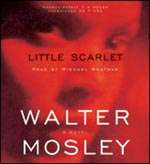Little Scarlet (Easy Rawlins Mysteries), by Walter Mosley and Michael Boatman (Narrator)
By the title, one would not expect the story to involve race riots in Watts in the '60s, but the murder victim was a young black woman who was known as "Little Scarlet" because of her reddish hair. This is Mosley's eighth Easy Rawlins thriller, and with each mystery Easy discloses more and more of what drives him to live and work the way he does. The backdrop of the volatile race relations of the '60s gives Easy the opportunity to voice the pain, anger and frustration felt by men and women as a result of discrimination.
Mosley's excellent writing and Michael Boatman's sensitive narration combine to create a vivid portrait of a difficult time in U.S. history. Through Easy's reactions to the things he sees and the people he meets, we hear Mosley teaching us what it was like to be an intelligent African American man in an insane world.
In addition to being a study of Watts in
the time of the riots, this story is a cliffhanger that keeps
the listener tuned in to hear the final results. I liked hearing
the insights of people who could actually have been in Los
Angeles in 1965, and it gave me a greater understanding of
the plight of the people at that time and their reasons for
rioting. I recommend this book both as a thrilling nail-biter
and as a thoughtful history lesson.
John
Mormon
9/4/05

